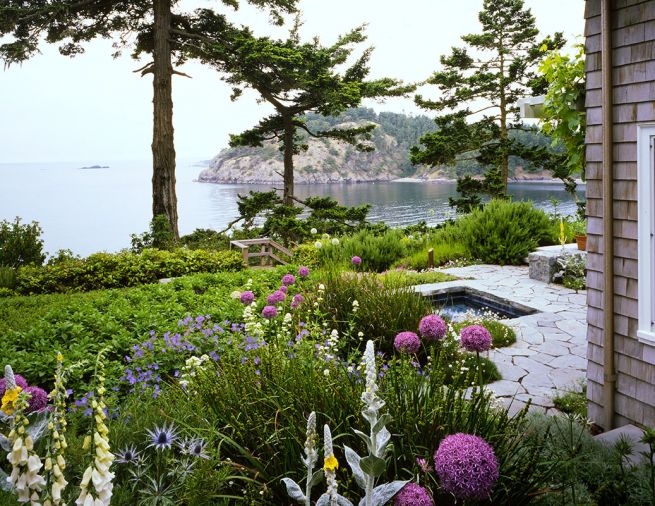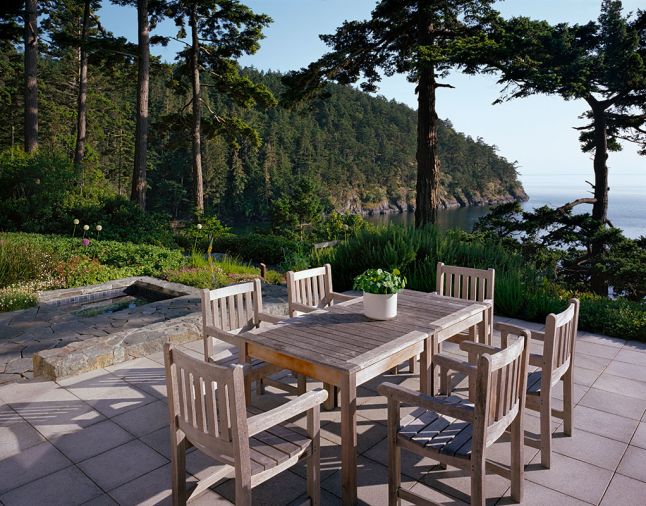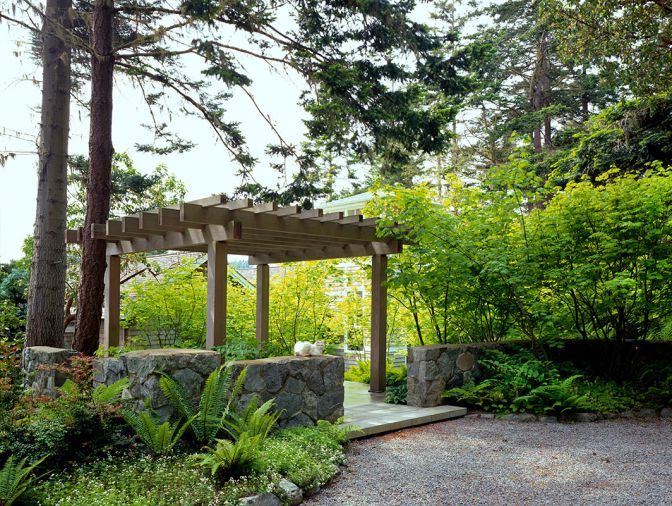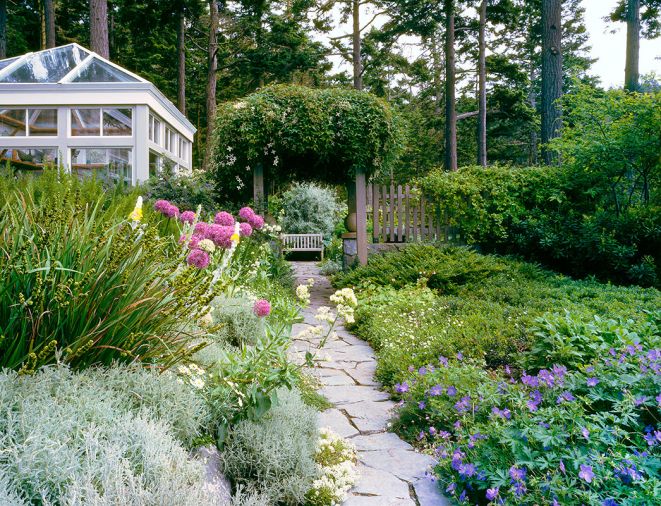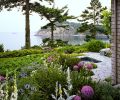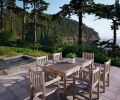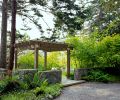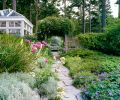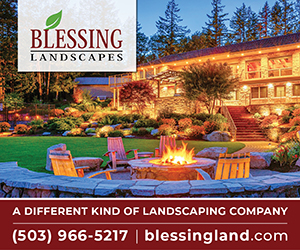For British born landscape designer Paul R. Broadhurst, of Broadhurst + Associates in Seattle, creating a woodland garden on Lopez Island was an odyssey of sorts, combining the site’s history with the women who once cultivated it, the wildlife that flies over and meanders through it, along with the sound of the gentle waves that perpetually lap against the horseshoe bay that borders it.
The odyssey began with an invitation from Jim Addington and his newly wedded wife, Lynne, to view - first from the air - the property they had just purchased. It was breathtaking, says Broadhurst, to see the perfectly remote bay surrounded by rocky bluffs and a forest of evergreens.
For five nights, Broadhurst inhabited the spartan house the elderly women had made their home, as he acquainted himself with what they had done to protect their garden spaces from the deer that grazed hungrily through it.
“I’d just seen ‘The Whales of August’ about two aging sisters, played by Lillian Gish and Bette Davis, and their lives spent living in an old saltbox cottage off the Coast of Maine,” recalls Broadhurst, “so I was thinking of them as I romanticized about how these two women on Lopez had lived, growing their own food, bringing their supplies in by boat and hauling them up with a large winch still embedded in a tree.”
Teaming with architect Jodie Carrol, Broadhurst developed the site around the “remodeled” home Carrol designed. “We retained one of walls of the original house so we could grandfather in its footprint,” explains Broadhurst, “which is wonderfully close to the view.”
Broadhurst artfully suspends the “crème de la crème” moment of viewing the spectacular horseshoe bay by moving the car park to a distant part of the land. “I wanted to do something unusual for Lynne, who loves to garden,” he says. “Because the surroundings are so spectacular, I installed a Pacific Northwest forest of Doug firs and lovely vine maples to walk through first to block the view.”
A type of porte cochere acts as a welcoming area, taking you down a set of switch-back concrete tile stairs, prolonging the beauty of the spectacular bay view that awaits once you’ve entered the home’s front door.
Forever cognizant of the bedrock upon which the property sits, the limited well water and possible saltwater intrusion, Broadhurst introduced 25 native species that could weather the droughty conditions often found in the San Juan Islands.
To keep the wildlife out of the various gardening areas designed for Lynne’s pleasure, Broadhurst created a walled Sun Garden separated from the wilder woodland areas he installed that harken back to the existing forest.
“It is a wild place,” says Broadhurst, “and we did not want it gussied-up with all kinds of non-local plants and flowers. So, we limited our ornamental planting to two walled garden enclosures - mimicking the ‘ladies’ original stacked rock and chicken wire deer-proof garden. It was in these spaces - the Sun and Shade Gardens - that we felt comfortable in building ‘gardens’. Outside of these spaces, we accentuated the local, native wild plants. But because we wanted to be playful and create the sense of a fecundity, some of these ornamental flowers have escaped their allotted corral and bloom just outside. This adds charm and whimsy and domesticates these wild edges.”
Indeed, Broadhurst always tries to tap into the history of a place. Here, by honoring the wildness and the ‘ladies’, as he calls them, along with the gentleness of their intent, gave his design a better kind of resonance. “What sets this project apart,” he says, “is its hoped-for respect for the natural context and a gentle tipping of the hat to two people that lovingly tried to work in harmony with it.”
PROJECT SOURCES
LANDSCAPE DESIGNER
Broadhurst + Associates
www.broadhurstassociates.com
Bayside Garden PLANT LIST
Allium, Amelanchier, Johnson’s Blue geraniums, fox glove, native mullein, libertia, native vine maples, vancouveria, sword fern, eryngium zabelii, native myrica, salah, kinnickinnick, santolina, milkweed, clematis Montana wilsonii, hostas.
Shoptalk - Paul R. Broadhurst
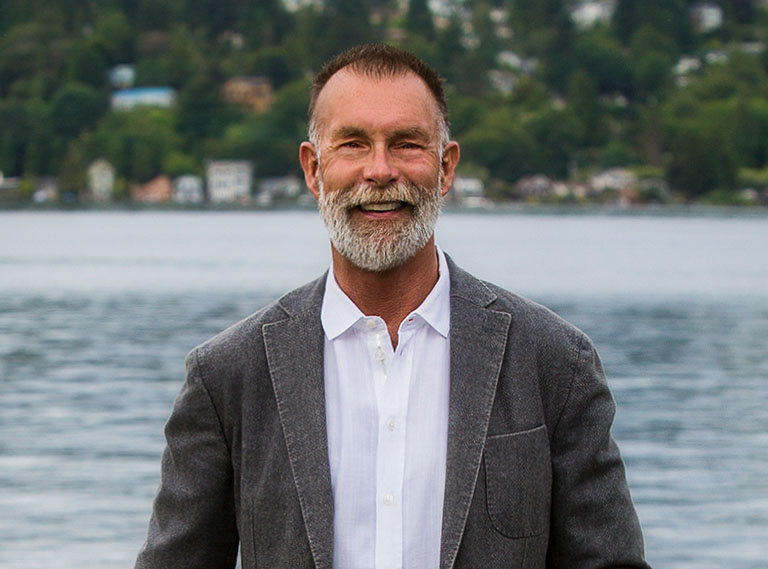
Paul R. Broadhurst
You mention being raised in a small town south of London. How did growing up near the English countryside influence your future work in landscape design?
There is a tremendous coziness to the English countryside—it is a domesticated wilderness. You can always find a way to insert yourself into it in a pleasing way. A footpath across fields that may have been a public right-of-way for 500 years could lead to a pub for lunch. Along the way, birds and wildlife might cross your path. At dusk a badger might amble by on its own established trail that leads to its sett. I love that, as a human, I can uniquely flex my creativity to design spaces which can encourage a diversity of connections.
You describe yourself as a humanist and an environmentalist. How does that translate into your landscapes?
We are an unusual animal, arguably unique. I try to understand the human condition at a simple level, say, what gives pleasure and then by designing outside space I blur the margin between built and unbuilt and provide opportunities to re-engage with nature’s rhythms.
Can you share a few of your favorite gardens, worldwide?
Denmans Garden in West Sussex, England, and the Donnell Garden in Sonoma, California, were both influential. The countless “gardens” that comprise Versailles. The Generalife at the Alhambra, Granada, Spain. All these places are tangled up with associated memories with friends and the nearby countrysides.
Do you have a specific plant or a particular flower that you love?
Manzanita ‘Howard McMinn.’ Here is an “improved” plant cultivar that has not lost touch with its innate wildness. It is a gnarly thing in a good way. Nicotiana Aztec Jasmine. My summers would be bereft without it. The scent evokes a lifetime full of fond memories.
How did you start your career as a landscape designer?
Formally, as soon as I wrapped up my master’s degree in landscape architecture, in the early 90s. But informally, I have been refining my skills for many years before this. I can’t remember not designing.
Describe your personal garden.
I live in a very high-density neighborhood, so we have terraces with everything in oversized pots. A very old elm tree just collapsed on our street corner and it shaded 60% of our space. The tree supported an entire urban ecosystem. I will miss the associated comings and goings of wildlife. I like aromatics and fragrance, so our pots are stuffed with artimisia, lippia and scented-leaf geraniums, to name a few—anything that I can brush past, pinch and grab, as I head out to start my day. I smell my fingers as I am driving. In the evening, I return to star jasmine, honeysuckle and scented nicotiana. I am guilty of terrorizing our local squirrels, but they always seem to have the upper hand.
Many of your landscapes create or restore the connections between plants, wildlife, and people. Why is this important?
We are increasingly divorced from the natural world—its rhythms and natural processes. My work is all about having a mindfulness to our connection with it. It’s about building relationships. But then, isn’t everything, really? If a design facilitates a wider perspective, all kinds of things can then start to open up.
A crevice fern thriving in cool gritty soil, softening the outlines of a large sun-warmed rock; a flower that attracts hummingbirds; a seat to share with a friend under the canopy of a small tree. All these things can exist within a 15-foot radius.

